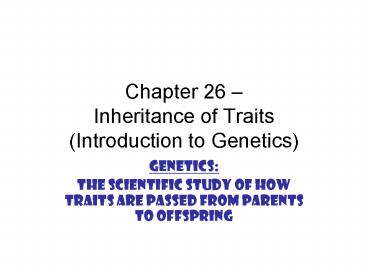Chapter 26 Inheritance of Traits Introduction to Genetics - PowerPoint PPT Presentation
1 / 25
Title:
Chapter 26 Inheritance of Traits Introduction to Genetics
Description:
You get your genes from your parents ... Blondes do not all have blue eyes, brunettes do not all have brown eyes. Way we study today... – PowerPoint PPT presentation
Number of Views:281
Avg rating:3.0/5.0
Title: Chapter 26 Inheritance of Traits Introduction to Genetics
1
Chapter 26 Inheritance of Traits(Introduction
to Genetics)
- Genetics
- The scientific study of how traits are passed
from parents to offspring
2
Inheritance
- You get your genes from your parents
- In meiosis, half of the chromosomes in a pair
come from the Dad, half come from the Mom - What we know today is based on the work of Gregor
Mendel Austrian monk
3
Figure 14.0x Mendel
4
Mendels Peas
- Worked with garden peas why?
- 1. pea plants were easy to get
- 2. did not cost very much
- 3. were easy to grow required little care,
hard to - kill
- 4. grew rapidly
- 5. had obvious, contrasting traits
- 6. reproductive structures were easy to
control for self-pollination vs.
cross-pollination
5
Figure 14.1 A genetic cross
6
Mendelian laws of inheritance
7
Pollination
- Defined as male pollen getting transferred to
female part of plant - BUT -- Pollination does NOT guarantee
FERTILIZATION - Pea plants normally self-pollinate (pollen goes
to female parts on SAME plant because flowers are
closed so, babies are clones of parent) - This gave rise to true-breeds for Mendel
- He crossed the true breds and saw that he could
get predictable results even if two different
traits were present in the parents.
8
The pollen pathway
9
Mendel studied 8 different pea plant traits
- Trait a specific characteristic that varies
from one individual to another - (ex. Seed color, height, hair color)
- Mendels studied traits had two contrasting
characters or alleles -- different forms of a
gene
10
Figure 11-3 Mendels Seven F1 Crosses on Pea
Plants
Section 11-1
Seed Shape
Flower Position
Seed Coat Color
Seed Color
Pod Color
Plant Height
Pod Shape
Round
Yellow
Gray
Smooth
Green
Axial
Tall
Wrinkled
Green
White
Constricted
Yellow
Terminal
Short
Round
Yellow
Gray
Smooth
Green
Axial
Tall
Flower color purple (P) vs. white (p)
Go to Section
11
Genetic Terms to know
- Dominant
- Recessive
- Heterozygous
- Homozygous (will either be dominant or
recessiveMUST include one of these terms with
homozygous) - Punnett square
- Monohybrid cross
- Dihybrid cross
- Expected vs. observed results
- Testcross
- P1, F1, F2 generation labels
12
Testcross
- Designed to reveal the genotype of an org that
exhibits a dominant trait - (it is homozygous dom or heterozygous?)
- Involves the breeding of a recessive homozygote
with an organism of dominant phenotype by unknown
genotype
13
(No Transcript)
14
Mendels test crosses.
- Testcross experimental cross between an
individual with the dominant phenotype for a
given trait (genotype unknown, though) and
another individual with the recessive phenotype
(homozygous recessive) - P1 generation parents that Mendel
cross-pollinated - F1 generation offspring of P1 that were allowed
to self-pollinate - F2 generation offspring of F1 generation
15
Figure 14.2 Mendel tracked heritable characters
for three generations
16
- P1 Tall X short
- F1 all tall Tall X Tall
- F2 ¾ tall, ¼ short
17
(No Transcript)
18
Mendels Conclusions.
- Biological inheritance is determined by factors
that are passed from one generation to a next
today, called genes - Principle of Dominance where there are two or
more forms of a gene for a single trait, some
alleles are dominant and other alleles are
recessive (some show, others do not and are
hidden) - Law of Segregation alleles separate from each
other during the process of meiosis (gamete
formation) - Principle of independent assortment genes for
different traits can separate independently
during the formation of gametes - Ex. Blondes do not all have blue eyes,
brunettes do not all have brown eyes
19
Way we study today
- Uses a chart to show crosses Punnett Square
- Chart is filled in with letters that represent
the different letter combinations that are
possible (GENOTYPES) - From the genotypes, the physical appearance can
be determined (PHENOTYPES)
20
Figure 14.5 Genotype versus phenotype
21
(No Transcript)
22
Punnett Square
- Device for predicting the results of a genetic
cross between individuals of a known phenotype. - Developed by R.C. Punnett
- Rules
- 1.must predict possible gametes first
- 2. male gametes are written across top, female
gametes on left side - 3. when read Punnett, start in upper left corner
and read as if a book WRITE OUT GENOTYPES IN
ORDER
23
Board examples
- Character flower color
- Alleles Purple (P) and white (p)
- Genotypic Combos possible
- two dominants PP (homozygous dominant)
- two recessives pp (homozygous recessive)
- One of each Pp (heterozygous)
24
Phenotypes physical appearance
- PP looks purple, so phenotype is purple
- pp looks white
- Pp looks purple (white is masked, but still
part of genotype)
25
Monohybrid crosses only one character
considered
- Steps to do
- Write out genotypes of parents
- Write out possible gametes produced
- Draw 4 box Punnett square
- Put male gametes on top, female on left side
- Fill in boxes
- Determine genotypes by reading Punnett starting
from top left - Determine phenotypes by reading from genotype
list - Ex.
- White flowered plant X Purple flowered plant
- Yellow peas X Green peas
- Tall plant X short plant































